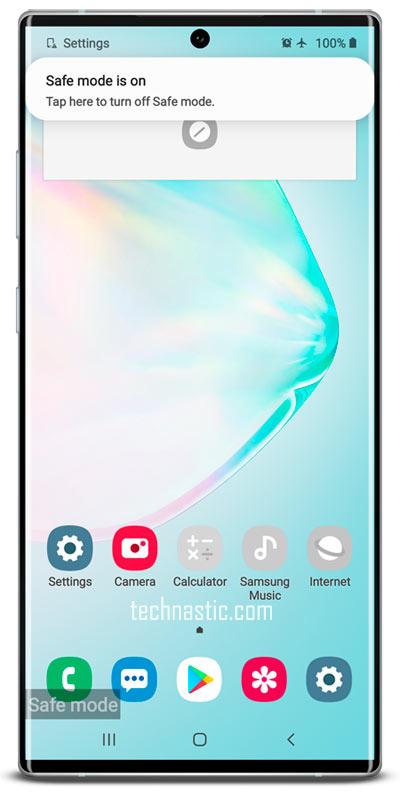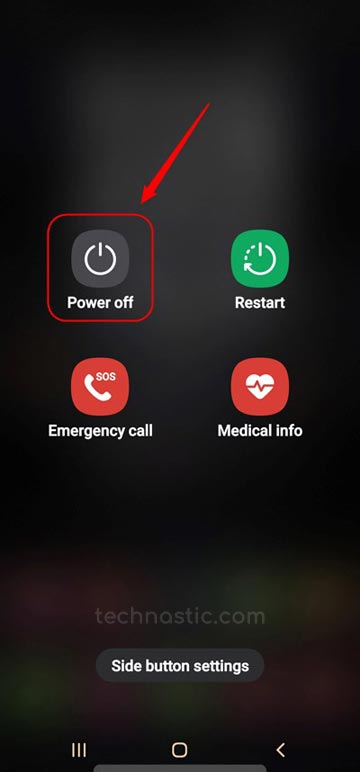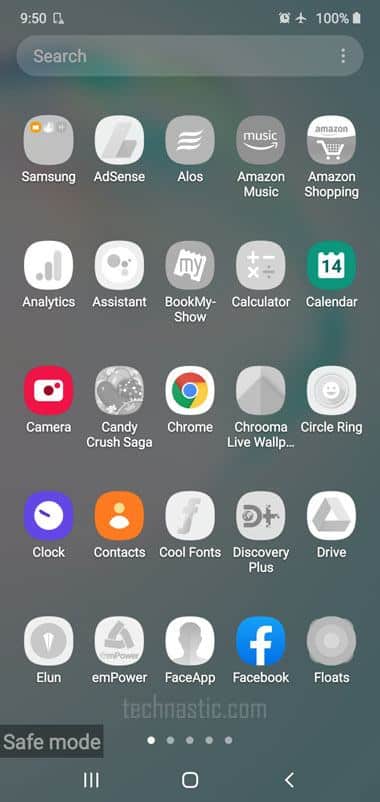- Hold the Power button to open the Power Menu, long-press the Power off icon, and tap the Safe Mode icon.
- In an ADB environment, execute the following command to enter safe mode:
adb shell setprop persist.sys.safemode 1
Android’s Safe Mode works like a diagnostic tool to troubleshoot and resolve software-related issues. Its main purpose is to find whether a device problem is caused by a third-party app, the OS itself, or the device hardware. In Safe Mode, your Android phone or tablet boots up only with system apps. All 3rd-party apps are restricted, and the Flight Mode is enabled automatically. In this tutorial, we’ll describe 4 ways to enter Safe mode on Android devices.
Please do not confuse Safe Mode with Download Mode or Recovery Mode, as they are different.

A rogue app installed on your Android phone might cause one of the problems listed below:
- Sudden bump in battery drain.
- Connectivity issues with mobile data, Bluetooth, Wi-Fi, NFC, etc.
- Interference with incoming or outgoing calls.
- Device overheating issues.
- Unexpected increase in mobile data consumption.
- Intrusive ads and pop-ups.
- Abrupt device restarts.
- Frequent device freezes and app crashes.
- Slow performance.
In Safe Mode, you can identify problematic apps causing one of the above issues. Below, we’ve listed 4 methods to boot Android devices into Safe Mode. However, depending on OS versions and OEMs, all the methods might not work on all Android phones and tablets.
1. Hold the Power off Button in the Power Menu
Note: This method works on Samsung (phone and tablet), OnePlus, Google Pixel, Nokia, LG, Motorola, and Realme devices. It might not work on Xiaomi, Redmi, Huawei, Honor, Vivo, or Oppo smartphones.
- Hold the Power button to bring up the Power menu on your device.
- Touch and hold the Power off option until the Safe Mode icon or Reboot to Safe Mode prompt or pop-up appears.

- Tap the Safe mode icon or OK.
Your Android phone or tablet will restart into Safe Mode.
2. Hold the Volume Down Key on the Boot Animation
This method to boot into Safe Mode works on all Android phones and tablets.
- Power off your Android device and then power it on. You can also use the Reboot or Restart option.
- When you see the Powered by Android logo on the boot screen, hold the Volume Down key.
- Xiaomi and Redmi: Wait until the Xiaomi or Redmi logo disappears, and you see the ‘Powered by Android’ on the screen.
- Vivo: Hold the Volume Down button when the ‘Powered by Android’ logo disappears.
- Oppo: Hold the Volume Down key when you see the Oppo animation.
- Huawei and Honor: Press and hold the Volume Down key when you see the Huawei and Powered by Android logo.
- Keep the Volume Down key pressed until your device boots up and you see the Safe Mode watermark at the bottom left corner of your phone’s screen.
3. Hold the Volume Up + Down Keys on Boot Logo Screen
This method is the same as Method 2 with the addition of the Volume Up key.
- Power off and restart your phone or reboot it.
- When you see the boot animation logo (Powered by Android), hold the Volume Up + Volume Down keys together.
- Your Android device will boot into Safe Mode.
4. Using ADB Command (Requires Root)
You can also boot an Android phone or tablet into Safe Mode using ADB Shell commands. However, you need root privileges on your Android device for this method to work.
- Download and install the latest Android USB driver for your device on your computer.
- Enable USB debugging from Settings > Developer options on your device.
- Download and extract the latest SDK Platform-tools.zip on your desktop. Open the extracted folder, right-click an empty area, and select the Open in Terminal option to launch a command window.
- Connect your phone or tablet to the computer, and execute the “adb devices” command to check the connection.
- Now, type the following command and press the Enter key.
adb shell
- You need to execute the following ADB shell command to enable the Safe Mode on your device.

ADB Shell command to enable Safe Mode setprop persist.sys.safemode 1
- If the above command doesn’t work, try the following command instead.
echo "1" > /data/property/persist.sys.safemode
- It’s time to reboot your device using the following code.
-
adb reboot
-
In case your Android device is rooted and has a custom recovery like TWRP installed, you can also use the following commands.
- Reboot your device into Recovery Mode. You can use the “adb reboot recovery” command for that.
- Go to the Mount option in the recovery menu and mount the data and system partitions.
- Connect your device to the computer via a USB cable.
- Launch the command prompt window and execute the following commands one after one.
adb shell echo "1" > /data/property/persist.sys.safemode adb shell chmod 600 /data/property/persist.sys.safemode
- Now, go to the main menu in the recovery and select the Reboot option.
Your Android device should reboot into Safe Mode. If you boot your device to normal, try these methods to turn off Safe Mode on Android.
How to Open Apps in Safe Mode on Android
Due to the diversity in various Android devices and OS versions, app developers write extra bits of code to make the app compatible with a wide range of chipsets and OS versions. Due to this fragmentation problem, some apps might act weirdly on some devices or OS versions. However, the worst thing is that you can’t distinguish whether the issue is from an app or it is system-related. In such situations, the Safe Mode feature on Android can help you. All downloaded apps on your Android device are disabled by default in Safe Mode.
Now, the question is, how can we determine which app or apps might be creating problems on your device? You can consider the following things to find out the culprit.
- Try to recall the names of the apps you installed before you started having problems.
- If your device encountered a boot loop after installing or opening an app, you can uninstall it to solve the issue.
- Some apps automatically start as soon as your phone boots up. Such apps might create issues. Custom clock, weather widgets, and home launcher apps come in this category.
- If you have too many apps, try removing the unused ones.
Once your Android device has entered Safe Mode, go to Settings > Apps > All Apps and uninstall the apps or games you think might be causing the problem. In most cases, it is some recently installed app that causes them. Try uninstalling apps one by one and restarting your phone after each installation to check if the problem you were having has been fixed.

